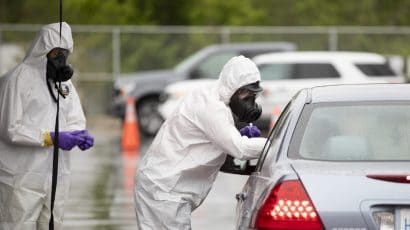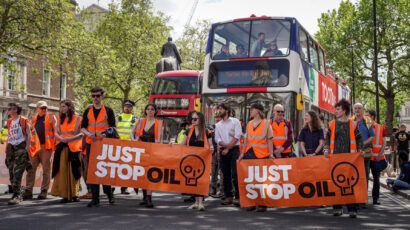Carbon capture has a long history. Of failure
By Bruce Robertson | September 1, 2022
 Photo by Chris Liverani on Unsplash
Photo by Chris Liverani on Unsplash
Carbon capture and storage is an old technology, first commercialized in the 1970s. Back then it was called enhanced oil recovery, because the carbon dioxide recovered from oil and gas production was injected into depleted oil and gas reservoirs to re-pressurize them and extract more hydrocarbons.
As the climate change movement gained momentum, the oil and gas industry wisely rebranded enhanced oil recovery as a “climate-friendly” process with a new name: carbon capture utilization and storage. Today, over 70 percent of carbon capture projects are, in fact, enhanced oil recovery projects used to produce more oil and/or gas, resulting in yet more greenhouse gas emissions.
The Institute for Energy Economics and Financial Analysis has estimated that most of the total captured carbon throughout history found its use in enhanced oil recovery—approximately 80–90 percent. Only a small proportion of carbon capture projects (approximately 10–20 percent) have stored carbon in dedicated geological structures without using it for oil and gas production.
Despite its long history, carbon capture is a problematic technology. A new IEEFA study reviewed the capacity and performance of 13 flagship projects and found that 10 of the 13 failed or underperformed against their designed capacities, mostly by large margins.
The natural gas processing sector dominates the application of carbon capture technology. The gas production process requires the removal of carbon dioxide. While many gas companies now claim to produce “carbon-neutral” gas or liquefied natural gas, this is little more than marketing hubris.
The “carbon-neutral” tag has been obtained by using carbon capture to capture the 10–15 percent of Scope 1 and Scope 2 emissions (the emissions generated from producing natural gas) during the gas production process or by purchasing carbon offsets. Yet up to 90 percent of emissions from oil and gas do not occur at production. Instead, these emissions, called Scope 3 emissions, occur when the product is actually used, that is, burnt. As shown in our study, capturing Scope 3 emissions, the biggest chunk of emissions created from using the product, is not being accounted for in these “carbon-neutral” claims.
Apart from the poor performance of carbon capture projects, carbon capture in power plants has shown a track record of technical failures since 2000. Close to 90 percent of the proposed global carbon capture capacity in the power sector has failed at the implementation stage or was suspended early.
Even if the carbon dioxide can be injected underground, there is no guarantee that it will stay there and not leak into the atmosphere.
There are several real-world examples of failure to keep gas underground. The best example is the California Aliso Canyon gas leak in 2015, the worst man-made greenhouse gas disaster in US history, when 97,000 metric tons of methane leaked into the atmosphere. While the leak at Aliso Canyon was a methane, not carbon dioxide, leak, depleted oil and gas reservoirs are commonly used to store captured carbon dioxide. The problems encountered at Aliso Canyon could also be encountered with carbon dioxide at a carbon capture project.
Another failure was the In Salah project in Algeria, a carbon capture project with a total cost of US$2.7 billion. Injection started in 2004 and was suspended in 2011 due to concerns about the integrity of the seal and suspicious movements of the trapped carbon dioxide under the ground.
The entire efficacy of the carbon capture process has been called into question by the Intergovernmental Panel on Climate Change. In its special report on Carbon Dioxide Capture and Storage, the IPCC stated:
“CO2 storage is not necessarily permanent. Physical leakage from storage reservoirs is possible via (1) gradual and long-term release or (2) sudden release of CO2 caused by disruption of the reservoir.”
Carbon capture has been used as a justification for new oil and gas projects. It has a history of poor performance, only captures a fraction of the total emissions from the lifecycle of oil and gas production and its long-term efficacy is questionable.
It is no solution for a climate-constrained world.
Together, we make the world safer.
The Bulletin elevates expert voices above the noise. But as an independent nonprofit organization, our operations depend on the support of readers like you. Help us continue to deliver quality journalism that holds leaders accountable. Your support of our work at any level is important. In return, we promise our coverage will be understandable, influential, vigilant, solution-oriented, and fair-minded. Together we can make a difference.















The most interesting statement. “Yet up to 90 percent of emissions from oil and gas do not occur at production. Instead, these emissions, called Scope 3 emissions, occur when the product is actually used, that is, burnt. As shown in our study, capturing Scope 3 emissions, the biggest chunk of emissions created from using the product, is not being accounted for in these “carbon-neutral” claims.”
The fact that carbon capture doesn’t work is nothing new. It is an invented hoax by the O&G industry to keep on going on with their dirty business.
The real solution is burning less and less oil and gas.
Plant trees, and don’t cut down forests anymore.
The real solution could be green farming.
Carbon capture has a lot of issues but this hatchet job is full of factual issues and innuendo.
For example, EOR has nothing to do with carbon capture. Also, CO2 was not injected into depleted reservoir. That obviously makes no sense if the objective is to recover more oil.
Carbon capture may not be a good thing but misleading “facts” do little to further a constructive dialog.
EOR was the first implementation of carbon capture. This is from the Royal Society policy briefing document: “In the 1970s, the injection of CO2 into oilfields to enhance oil recovery (EOR) emerged. During EOR, injected CO2 is cycled through a reservoir a number of times before being permanently trapped in the subsurface. Around 20 MtCO2/ yr is permanently trapped in the subsurface via EOR operations.” The CO2 was pumped into oilfields until depletion, causing it to be trapped, thus storing it. EOR formed the basis of the technology that current CCS operations rely on, it has a lot to do… Read more »
This article is not completely factual and uses half-truths and misinformation to push the writer’s agenda. Fossil fuels are not going to disappear overnight, no matter what extremists think or do, and CCUS is going to help abate the emissions from fossil fuels. It is not a perfect technology and can be improved with sufficient investment and R&D as with all technologies.